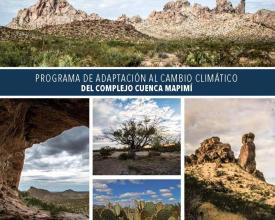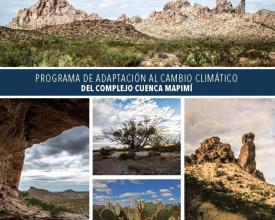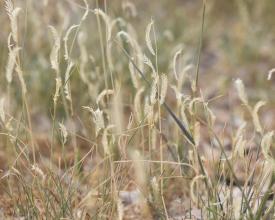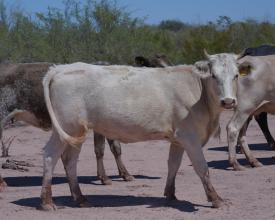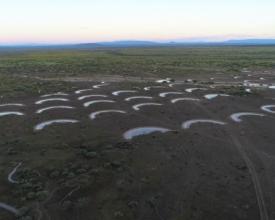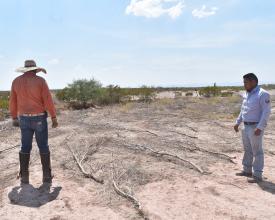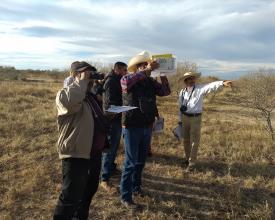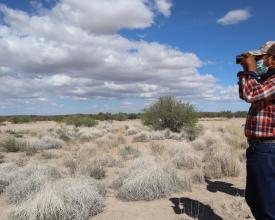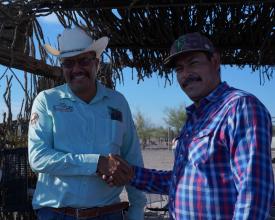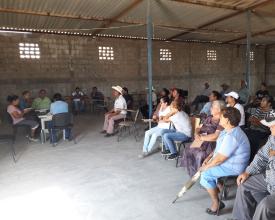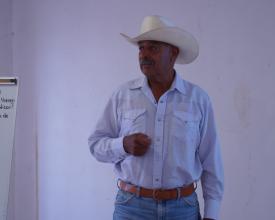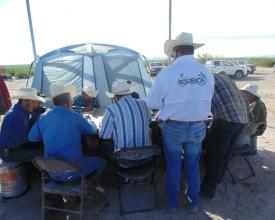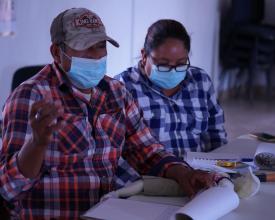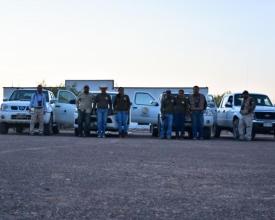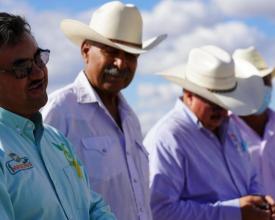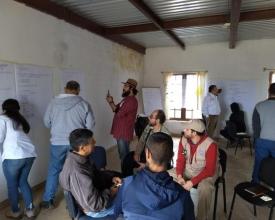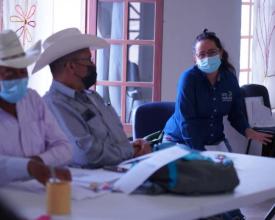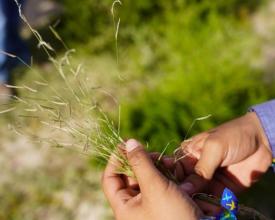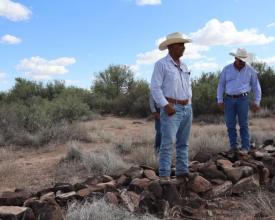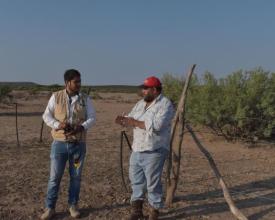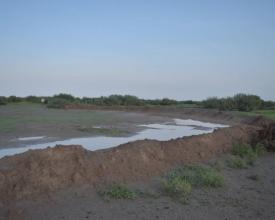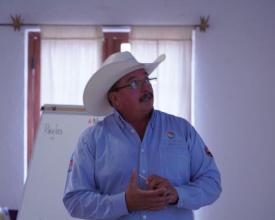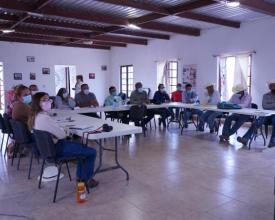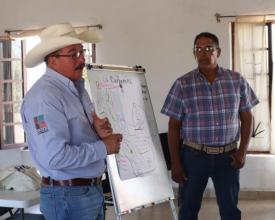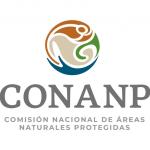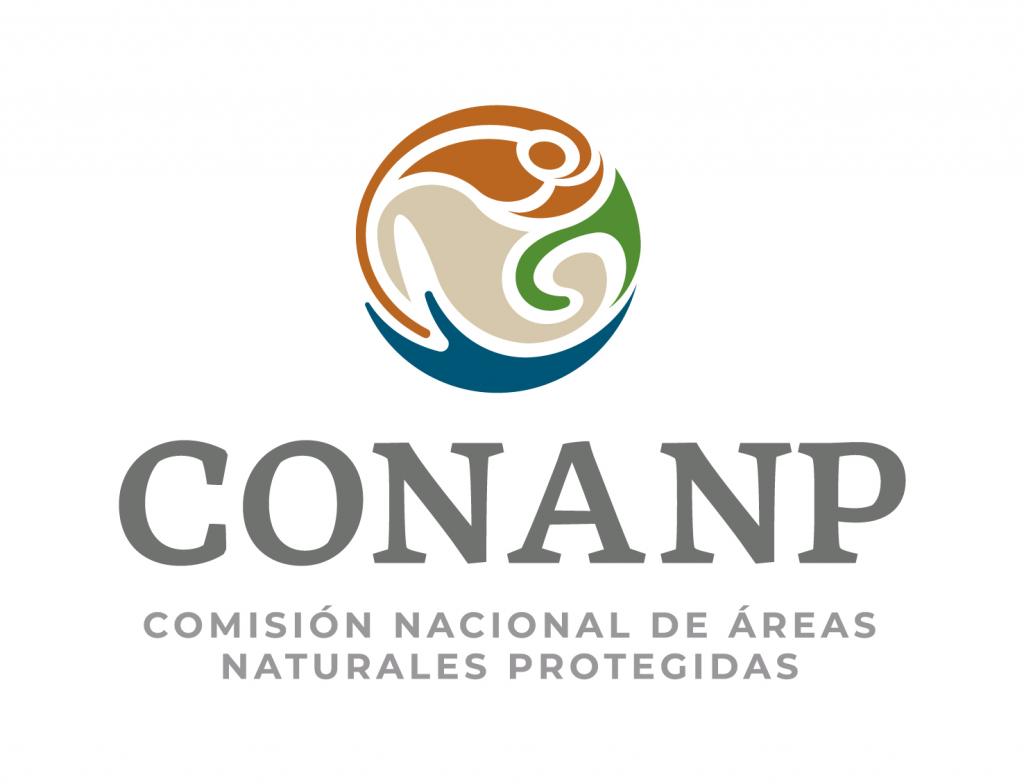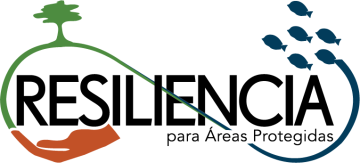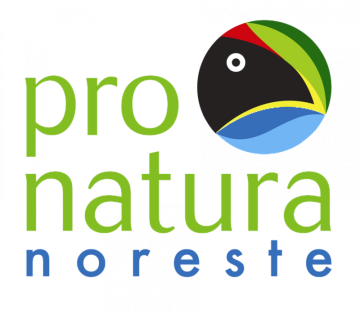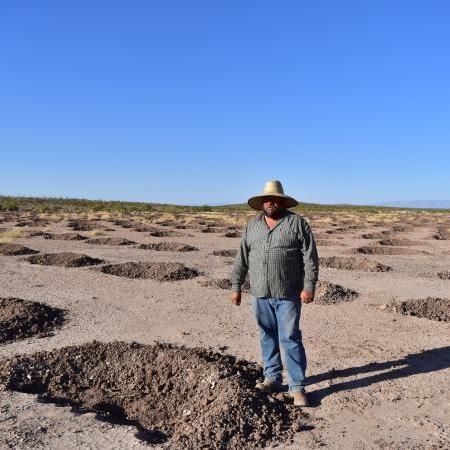
Mapimí Biosphere Reserve: Restoration of grasslands to face climate change
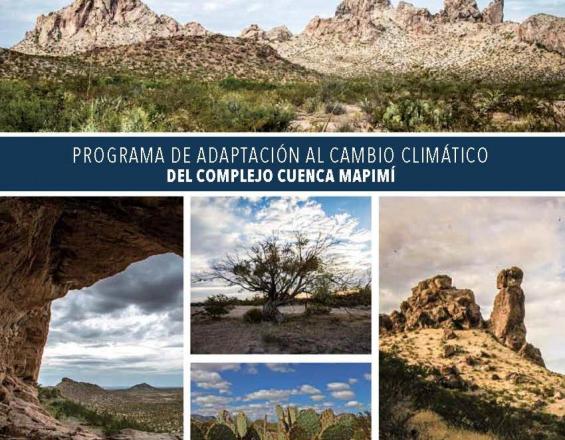
The Mapimí Biosphere Reserve (BR) is located in the states of Coahuila, Chihuahua, and Durango in Mexico. This BR is characteristic of the Chihuahuan Desert, and is home to a great diversity of flora and fauna. CONANP, which manages the BR, has spearheaded efforts to develop the Mapimí Basin Complex Climate Change Adaptation Program (PACC), which integrates measures to address climate change. Grassland restoration is an adaptation measure that was identified in a participatory manner and the success of its implementation was determined by the participation of the community and organized civil society, in this case Pronatura Noreste, A.C., among other success factors described in the building blocks. Five years after the restoration work began, an increase in vegetation cover was documented, which favored water infiltration and the creation of microclimates that lowered the site's temperature, thus reducing its climatic vulnerability.
Context
Challenges addressed
- The grasslands of the Mapimí BR have been used for intensive cattle ranching using overgrazing methods, which has led to ecological deterioration and habitat fragmentation.
- The Bolsón tortoise (Gopherus flavomarginatus), the largest land turtle species in North America and endemic to the Mapimí Bolsón, is at risk.
- The areas near the Natural Protected Area (NPA) have been deteriorated for 400 years due to overgrazing.
- One hundred years ago, the change in land use was due to mechanized agriculture. More recently it has been caused by the increase in human population.
- Invasive exotic species have been identified.
- Climate projections indicate that the region could experience increases in its average annual temperature and that water availability could decrease, which would increase pressure on natural resources due to overexploitation, generating negative effects on ecosystems.
- The BR has had a PACC in place since 2014.
Location
Process
Summary of the process
Building block I "creating a sense of belonging to the local ecosystems" through a planned extension scheme, has been the basis for the rest of the building blocks of this solution, as it is about creating a willing workforce for the arduous work of rehabilitating the ejidos. The rest of the building blocks of this solution help the further development of the identity of the local communities as part of their local ecosystems.
The "sense of belonging" (block I) awakened the communities' interest in ecosystem conservation and favored "community organization" (block II), which made the construction of the micro-watersheds possible.
Intersectoral work and community participation (block III) paid off, thanks to the sense of belonging (block I) and organization (block II) that existed at the local level, which was decisive for successful implementation.
"Experimenting with new methods, ideas and approaches in a limited area" (Block IV) showed the usefulness of conservation, including the economic benefits for local communities, for which it is necessary to "continue promoting livestock management and grassland restoration" (Block V).
Building Blocks
I. Create a sense of belonging to local ecosystems.
Without the involvement of the people, it is not possible to implement ecosystem conservation schemes at different scales. Therefore, it is important to raise awareness and work with local communities, in this case for the conservation of grasslands, through a local environmental education program that addresses the problems detected.
Identity can be developed by increasing people's awareness of the benefits of sustainable management in maintaining local livelihoods and people's quality of life, but it can also be further strengthened by encouraging the self-organized commitment of all members of the community, not only to make use of the different parts of the ecosystem to sustain livelihoods, but also to participate in its rehabilitation.
Enabling factors
- Openness and willingness of the community to internalize lessons learned.
- Development of environmental education programs on the Bolson Turtle and the grassland aimed at the local population.
- Linkage between managers, inhabitants, users and landowners of the Mapimí BR to work together and foster a sense of belonging and identity.
- Recognition of the benefits derived from sustainable rangeland management.
- Motivation and strengthening of community capacities to participate in ecosystem restoration.
Lesson learned
- The development of a link with the community and its awareness contributes to increase efforts for a transformation of attitudes and practices for ecosystem management and adaptation to climate change.
- Involving the community in ecosystem rehabilitation increases their commitment to sustainable management.
II. Community organization
Community organization has been a determining factor in the development of the restoration work. Initially, informative meetings were held, coordinated by BR personnel, to inform about the project, the objectives to be achieved, and to identify the intervention sites. A workshop was also held to identify the effects of climate change on the conservation targets and productive activities in the region. Subsequently, working groups were formed in the communities to carry out a field activity, with training and technical support from CONANP and Pronatura Noreste, A.C. for its implementation.
This organizational process was based on the efforts made by the Mapimí BR team to promote, through the Advisory Council, participatory planning, collaboration and joint decision making with respect to restoration. In this sense, livestock management programs have been established, involving landowners and land users in specific actions for grassland restoration.
Enabling factors
- The restoration strategy was developed in consensus with the landowners, considering their needs and with technical guidance from CONANP.
- Constant communication with the participants facilitated the development of project activities.
Lesson learned
- Community empowerment is essential to obtain favorable results that are sustainable over time.
- Strengthening community organization facilitates the development of activities that help reduce the vulnerability of human communities and ecosystems to climate change.
- The project was the first to use smooth fencing within the Mapimí BR. Initially, the ejidatarios questioned its effectiveness for livestock management and exclusion from the area, as it had always been used with barbed wire. In addition, the installation of the smooth fence requires a special device, which the ejidatarios did not have. After clarifying the ejidatarios' doubts, the device was obtained and the installation of the fence became much easier.
- It is important to adjust the scheduling of activities according to the availability of local people, as they have to combine their daily work with their collaboration in the project, which can hinder the progress of the work.
III. Intersectoral work and community participation
In order to implement resilience actions and mitigate the impacts of droughts, temperature increase and extreme weather events on socioecosystems, local partnerships are necessary. The articulation of efforts with local actors makes it possible to act according to common objectives, and allows for good coordination, the effectiveness of intervention actions, and local ownership in the long term. Working through alliances multiplies the resources available to generate actions, strengthens capacities and ensures sustainability/replicability. The continuity and permanence of the actions depend on the commitments established with other institutions, governments, civil society organizations and, above all, the trust generated in the communities, who are the ones who make the decision to manage the territories according to their needs and possibilities. The permanent presence of CONANP, through the Mapimí Biosphere Reserve team, and the participation of the community and organized civil society, in this case Pronatura Noreste, A.C., were decisive for the success of the adaptation measure implemented.
Enabling factors
- In the Mapimí BR, the grassland is a point of common interest for cattle producers, inhabitants, managers and conservationists, since it sustains both the Bolsón tortoise and cattle. Identifying elements of shared interest facilitates participatory processes for conservation.
- The awareness-raising, communication and training activities that have been promoted in the Mapimí BR have been decisive in articulating the participation of inhabitants, managers, landowners and other stakeholders in the restoration of local ecosystems.
Lesson learned
- Common objectives, empowerment of the actors involved and good coordination are fundamental elements for the long-term success of the actions implemented.
- Local alliances multiply resources to promote actions, strengthen capacities and ensure sustainability/replicability.
IV. Experiment with new methods, ideas and approaches in a limited area.
In the context of integrated management to recover soil productivity and organic capacity, and with the objective of reducing the vulnerability of the socio-ecosystem to climate change, support was provided to women and men from local communities to restore pastures. The implementation of the activities followed an ecological function recovery approach, focused on improving soil conditions to enable grassland restoration. In the case of arid zones, such as the Mapimí BR, it is necessary to change the perspective of excessive afforestation for one of soil reactivation, since the latter is what sustains life in this ecosystem.
The micro-watersheds allowed the recovery of the pastureland, which serves as food for the Bolsón turtle and is beneficial for cattle ranchers because of the increase in forage production. In addition, the landowners received training and paid wages for the restoration work. In addition, it is necessary to work with the producers so that they use the new pastures in an orderly and rational manner, in order to make the productive activity more efficient.
Enabling factors
- The environmental education efforts undertaken in Mapimí BR, as well as the planning and development of restoration work under a participatory approach, facilitated the construction of agreements to apply new management ideas.
- Training and technical support from the reserve and Pronatura Noreste, as well as the willingness of the local community, made it possible for them to get involved in the restoration actions.
- The Resilience project provided the resources for the restoration, including materials and labor.
Lesson learned
- Obtaining visible results provides an opportunity to demonstrate to local communities that innovation with sustainable practices brings benefits to the population.
- The technical support provided to local producers for restoration was decisive in recovering soil productivity and reducing their vulnerability to climate change.
- The payment of daily wages was a trigger for the involvement of the community in ecosystem restoration actions. This, together with the tangible results obtained five years later, contributes to community empowerment for the continuity of restoration work in the long term.
V. Encourage livestock management and rangeland restoration.
In addition to grassland restoration, the Mapimí BR promotes the implementation of good livestock management practices. CONANP works with the local population to plan the use of pasturelands and promote restoration actions, such as cattle exclusion areas, micro-watersheds, and the planting of native grasses, which improves the productive system and conserves the pasturelands. In this way, the resilience of the pasture is increased; the soil is reactivated to improve the habitat of wildlife, particularly the Bolsón tortoise, and the environmental services provided by the pasture are maintained, while increasing the capacity of the ejidos involved to deal with the degradation of ecosystems in a context of climate change.
The positive results obtained in the ejidos involved have strengthened the relationship between CONANP and the human communities that form part of the reserve. At the same time, they have motivated interest in replicating the restoration work in other sites. Participants have shared their experience with the restoration work in peer-to-peer discussions and a video was produced with the support of the Resilience project.
Enabling factors
- The work of the Mapimí BR and its allies to promote livestock management, restoration of local ecosystems and adaptation to climate change, together with the support of the Resilience project, generated conditions conducive to the development of restoration works.
- Positive and tangible results motivate project participants to share their experiences, attract the interest of other community members and strengthen inter-sectoral collaboration.
Lesson learned
- The demonstration of positive results allows new actors to join restoration actions, to the benefit of local communities and ecosystems.
Impacts
After several years of education and awareness-raising work by CONANP (through the Bolson Grassland and Turtle Conservation Education Program) and Pronatura Noreste, A.C., the community was convinced that planning and rotational grazing with alternating breaks, combined with tools such as grassland restoration and grazing management, can help their livestock enterprises to be productive, the following impacts are observed:
- Habitat condition improved significantly, as the land regained pasture, which will directly benefit landowners by providing greater availability of feed for livestock, which implies an improvement in their carrying capacities.
- Water catchment and the accumulation of organic matter through the micro-watersheds allowed the recovery of native grasses and therefore food for the Bolson tortoise and other species, such as migratory birds.
- The execution of the restoration work provided direct economic income to the communities by providing a temporary salary to the day laborers.
- The communities involved in the project received practical training in the establishment of micro-watersheds, which will enable them to apply their knowledge in future restoration work.
Beneficiaries
- Local human population that benefits from the ecosystem services of the Mapimí BR.
- Producers and cattle ranchers.
- People who benefit from migratory birds and pollinators that use the grasslands during their migratory cycles.
Sustainable Development Goals
Story

The Mapimí BR conserves ecosystems characteristic of northern Mexico and is home to a great diversity of flora and fauna, including the Bolsón tortoise (Gopherus flavomarginatus), an emblematic species of the PNA. Cattle ranching is the main economic activity of the local inhabitants, so proper management represents a challenge for the conservation of the grasslands. In addition, the increase in average temperature and the decrease in water availability projected for the region as a result of climate change will increase the pressures on the ecosystems and the communities that depend on them. Faced with this scenario, CONANP has promoted the development of conservation, restoration, and climate change adaptation measures that address both biodiversity and the productive systems that converge in the ANP.
In 2017, with the Resilience project, the installation of 16.5 km of fencing for livestock exclusion and 40 ha of micro-watersheds for the recovery of native grassland vegetation was carried out in five ejidos of the reserve. The activities were carried out using a participatory approach, involving the local community in the planning and execution of the works. CONANP and Pronatura Noreste, A.C. provided training and technical support. Support included materials and payment of wages.
Five years after the restoration work began, the establishment of more than two species of annual grasses and one perennial grass, in addition to various herbaceous plants, has been documented. Vegetation cover at the site has increased compared to the landscape that was observed before the restoration work was carried out. The site is still fenced to exclude livestock, which will allow the perennial species to continue to establish favorably and develop sufficient roots.
The favorable results motivated the participants to share their experience in the project and attracted the interest of others from the local ejidos. In addition, they strengthened CONANP's relationship with the communities of the Mapimí BR, which is fundamental to continue promoting their participation in the conservation and restoration of the grasslands. They will also serve as a guide to orient and improve the planning of restoration actions in the NPA.

